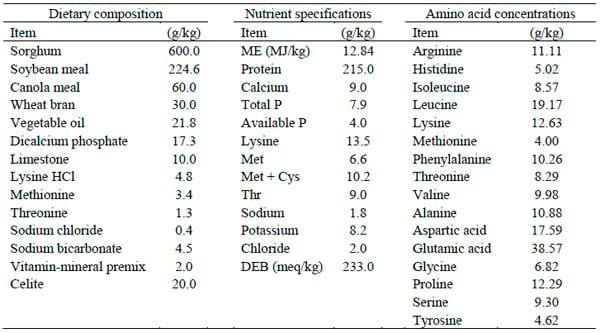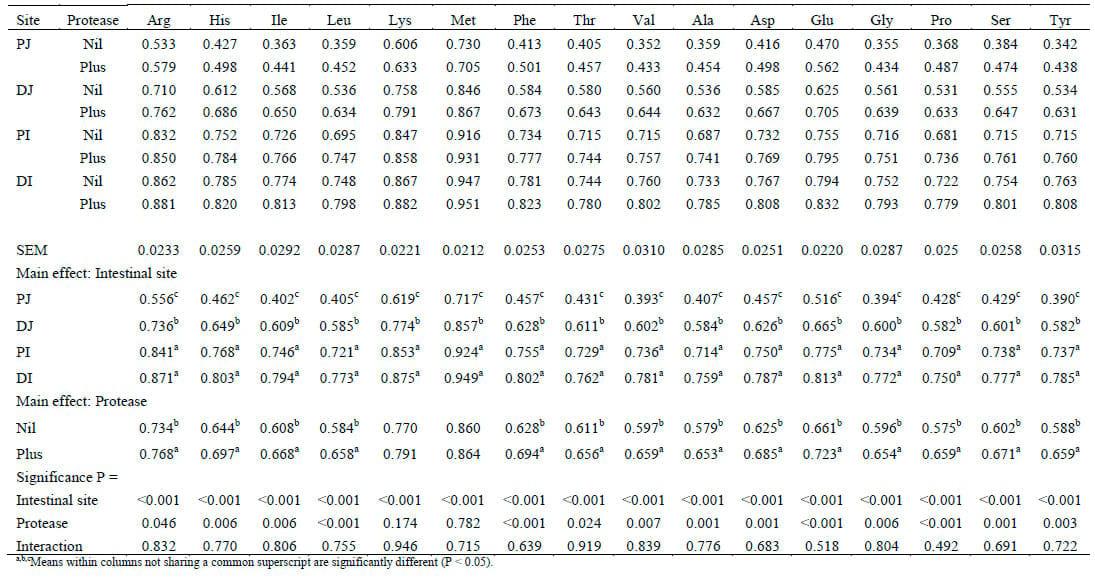I. INTRODUCTION
The effects of protease supplementation on nitrogen (N) and starch digestibility in four small intestinal sites of broilers offered sorghum-based diets were determined in an earlier study (Selle et al., 2012). Protease significantly increased N digestibility in the distal jejunum (0.538 vs. 0.627), proximal ileum (0.727 vs. 0.770) and distal ileum (0.719 vs. 0.770). Moreover, protease significantly improved starch digestibility in the distal jejunum (0.678 vs. 0.770) and proximal ileum (0.812 vs. 0.851). Thus, the intention of the present study was to determine the effect of protease on apparent amino acids digestibility throughout the small intestine given the observed improvement in crude protein (N) digestibility generated by this protease.
II. MATERIALS AND METHODS
The methodology used in this experiment has been previously outlined (Selle et al., 2012). Briefly, a red sorghum (Buster) was hammer-milled (3.2 mm) and incorporated into broiler diets that were steam-pelleted at 80 °C and offered to male Ross 308 chicks (seven replicate cages of six birds per treatment) without and with protease from 7 days to 28 days post-hatch. Dietary composition, nutrient specification and analysed amino acid concentrations of the experimental diets are shown in Table 1. Dependent on treatment, the exogenous protease was incorporated into the sorghum-based diet prior to steam-pelleting at 80°C. The enzyme was a serine endopeptidase from Bacillus lichenformis (CibenzaTM DP100; Novus International Inc.) with a protease activity of 600,000 units/g and a recommended inclusion rate 300 units/g of feed. The analysed protease activity in the relevant experimental diet was 257 units/g of feed or 86% of the recommended activity-and protease activity was not detected in the corresponding control diet. At day 28, digesta samples were collected in their entirety from the proximal jejunum, distal jejunum, proximal ileum and distal ileum, which were demarcated by the end of the duodenal loop, Meckel's diverticulum and the ileo-caecal junction and their mid-points, for apparent amino acids digestibility determination. Amino acids quantitative analyses were completed in duplicate as outlined by Cohen and Michaud (1993). Analyses of variance and tests of significance were performed as a 4×2 factorial array design using JMP® 9.0.0 where significance was determined when P < 0.05.
Table 1 - Dietary composition, nutrient specifications and analysed amino acid concentrations in a red sorghum-based broiler diet
III. RESULTS
The effects of small intestinal site and protease supplementation on apparent amino acids digestibility are shown in Table 2. Interactions between intestinal site and protease inclusion were not observed. Intestinal site significantly influenced apparent digestibility of all amino acids where digestibility in the ileal sites was greater than in the jejunal sites. The average digestibility was 0.466 in the proximal jejunum, 0.643 in the distal jejunum, 0.764 in the proximal ileum and 0.803 in the distal ileum. As a main effect, protease significantly improved the digestibility of proline (14.6%), alanine (12.8%), leucine (12.7%), tyrosine (12.1%), serine (11.5%), phenylalanine (10.5%), valine (10.4%), isoleucine (9.9%) glycine (9.7%), aspartic acid (9.6%), glutamic acid (9.4%), histidine (8.2%), threonine (7.4%), arginine (4.6%). Apparent amino acids digestibility are conventionally determined in the distal ileum where, in this study, protease significantly improved the ileal digestibility of proline (7.9%), alanine (7.1%), leucine (6.7%), serine (6.2%), tyrosine (5.9%), valine (5.5%), glycine (5.5%), phenylalanine (5.4%), aspartic acid (5.3%), isoleucine (5.0%), threonine (4.8%), glutamic acid (4.8%) and histidine (4.5%).
IV. DISCUSSION
Concentrations of amino acids in sorghum are variable and their ileal digestibility may be highly variable (Bryden et al., 2009); both factors probably contribute to the inconsistent performance of broilers offered sorghum-based diets. The dominant protein fraction in sorghum is kafirin and its proportion relative to glutelin influences both amino acid concentrations and digestibility (Selle et al., 2010). Taylor (2005) suggested that sorghum-based broiler diets may benefit from the inclusion of protease with the caveat that kafirin may not be readily degraded due to its poor solubility and disulphide linkages, especially following exposure to 'moist heat'. The Bacillus lichenformis-derived protease used in the present study can degrade feedstuffs with high cystine content and disulphide linkages and has been reported to enhance broiler performance in maize-based diets (Odetallah et al., 2003, Wang et al., 2008). This is one of the very few studies to investigate the impact of protease on the digestibility of amino acids in sorghum-based broiler diets.
Soybean meal was the largest contributor of amino acids in the experimental diets and amino acid digestibility in soybean meal is greater than in sorghum (Bryden et al., 2009). Kafirin contains relatively high levels of leucine (Selle et al., 2010). Therefore, the 12.6% increase in leucine digestibility observed here suggests that protease addition enhanced amino acid digestibility to a larger extent in sorghum proteins than in 'non-sorghum' proteins (soybean-meal).
Synthetic amino acids in the experimental diets contributed substantial proportions of methionine and lysine. The digestibility of these free amino acids is of a high order and this is consistent with high lysine (0.619) and methionine (0.717) digestibility in proximal jejunum in the sorghum-based diet without protease. This may explain why significant responses to protease inclusion were not observed for these amino acids. Moreover, in the present study, protease did not generate significant improvements in growth performance which also may have been due to the modest improvement in digestibility of these two essential amino acids in response to protease supplementation.
Ileal amino acid digestibility values are widely used in broiler feed formulation. However, amino acids digestibility in four small intestinal sites in the present study were not correlated with previously determined feed intakes, weight gains and feed conversion ratios (Selle et al., 2012). The rate at which amino acids are absorbed from the gut, especially the nutritionally critical amino acids, in relation to starch digestion and glucose absorption may have a greater bearing on growth performance and protein deposition than ileal digestibility coefficients per se. Thus, the kinetics of protein digestion and amino acid absorption relative to starch and glucose merits further research.
Table 2 - Effect of protease supplementation on apparent digestibility of amino acids in proximal jejunum (PJ), distal jejunum (DJ), proximal ileum (PI) and distal ileum (DI) in broilers at 28 days post-hatch
ACKNOWLEDGEMENT: We would like to acknowledge Mr. Bernie McInerney and his team at the Australian Proteome Analysis Facility of Macquarie University for their competent analyses of amino acids.
REFERENCES
Bryden WL, Selle PH, Cadogan DJ, Liu X, Muller ND, Jordan DR, Gidley MJ, Hamilton WD (2009) RIRDC Publication No 09/007, Rural Industries Research and Development Corporation, ACT, pp 18-20.
Cohen SA, Michaud DP (1993) Analytical Biochemistry 211, 279-287.
Odetallah NH, Wang JJ, Garlich JD, Shih JCH (2003) Poultry Science 82, 664-670.
Selle PH, Cadogan DJ, Li X, Bryden WL (2010) Animal Feed Science and Technology 156, 57-74.
Selle PH, Liu SY, Cai J, Cowieson AJ (2012) Animal Production Science (submitted).
Taylor JRN (2005) Proceedings of Australian Poultry Science Symposium 17, 9-16.
Wang H, Guo Y, Shih JCH (2008) Animal Feed Science and Technology 140, 376-384.











